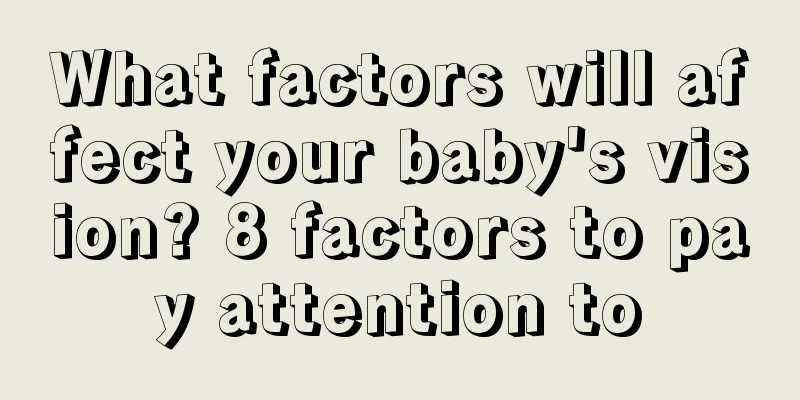What factors will affect your baby's vision? 8 factors to pay attention to

|
Eyes are the windows to the soul and need our good protection. So, what factors will affect the baby's vision? What factors can affect your baby's vision?1. Use a computer Our study, work, life and entertainment are almost inseparable from computers. Some people stare at the computer for too long and pay too much attention without blinking when working on it, which makes their eyes dry easily. After a long time, they will feel a foreign body, shed tears and even have blurred vision. 2. Reading and writing Reading and writing are both done with close-up fine vision, which mainly relies on visual cone cells. Excessive fatigue of visual cells will lead to fatigue of the entire visual system, and the eye muscles, eyeballs, etc. will undergo corresponding pathological physiological changes. 3. Watching TV The television itself is a flickering light source, and watching TV for a long time can easily cause fatigue. 4. Environmental factors Lighting that is too bright or too dim, inappropriate height of tables and chairs, etc. can affect vision. 5. Eye hygiene These include excessive fatigue, wiping eyes with dirty hands, and reading in bed. 6. Genetics Generally, myopia in preschool children is hereditary. 7. Diseases and drugs Vision can be affected by disease, by some medications and viruses, and by aging eyes. 8. Eating habits Good eating habits are the guarantee of healthy eyesight. It is very beneficial to eat foods containing vitamin A regularly, such as carrots, spinach, leeks, green peppers, red sweet potatoes, etc. What is normal vision for children?When a child is just born, he or she is generally in a hyperopic refractive state of 2.0-4.0D. Later, as the infant grows and develops, the eyeball becomes larger, the eye axis becomes longer, the corneal curvature increases, and gradually develops toward emmetropia. At 1 month old, the child's vision is light perception; at 3 months old, it is 0.02, which means that the child can track moving objects in front of the eyes; at 1 year old, it is 0.2; at 2 years old, it is 0.4; at 3 years old, it is 0.6, which means that the child can understand the vision chart and use the vision chart to check the vision; at 4 years old, it is 0.8; at 5 years old, it can reach 1.0, which is adult vision. If it cannot be achieved, you should go to the hospital for examination as soon as possible; at 6 years old, the vision can reach 1.2. Different standards should be used to judge whether vision is abnormal for children of different ages. Generally speaking, the lower limit of normal vision for 3-year-old children is 0.4, the lower limit of normal vision for 4-5-year-old children is 0.5, and the lower limit of normal vision for 6-7-year-olds and above is 0.7. If a child's vision is lower than the lower limit of normal vision for children of the same age, or the difference between the two eyes is more than 2 lines, it means that the child's vision is abnormal and he should go to the hospital for examination in time. How to test your baby's visionAs a new parent, it is necessary to know how to check whether your baby's vision is normal. Here are a few simple ways to check your baby's vision: 1. Shine a flashlight into the eyes: When stimulated by light, the baby will close his eyes reflexively. If you lift the eyelids and shine the light directly into the pupil, you will find that his pupil shrinks. This shows that the baby's eyeballs can adapt to changes in the brightness of the external light, which is called pupil light reflex in medical terms. 2. Coordination between head and eyes: A common example is that when a baby lowers his head, his eyeballs will instinctively turn upwards; if his head tilts back, his eyeballs will look downwards. This is a sign that the baby has the ability to coordinate his head and eyes. 3. Short stare: You can do a simple experiment. The parent holds a big red ball and moves it back and forth slowly 20 cm in front of the baby's eyes. The baby has an innate sensitivity to bright colors and moving objects. He will stare at the red ball, and his head and eyes will move back and forth with the movement of the red ball. 4. Motor nystagmus: Use a cylinder with black vertical stripes (a bit like a barcode) and slowly turn it from one side to the other. While the baby's eyes are looking at it, the eyeballs will move horizontally back and forth as the cylinder rotates. This is called eye nystagmus, or visual motor nystagmus. How long does it take for a newborn's vision to develop normally?About one month after the baby is born, the hearing is basically fully developed, but the vision needs a long time to develop slowly. The baby can basically see as clearly as adults about 6 to 8 months after birth. Although the baby's eyes can see things when he is born, his brain cannot process this visual information, so for a period of time, everything the baby sees is blurry. As the baby's brain develops, what he sees becomes clearer and clearer, so he has the tools to understand and master the world around him. Although the baby can only see the face of the person holding him when he is just born, as the baby grows up month by month, the range he can see will become larger and larger. |
<<: How to deal with baby rash? Teach you how to deal with baby rash easily
Recommend
The complete list of baby names for the year of the rat with the surname Cao
Naming a baby is something that parents are very ...
Can babies with eczema be vaccinated? Is it necessary for babies to get imported vaccines?
After the baby is born, in order to enhance its o...
Does the child snore because he is sleeping soundly? What is the reason for the child snoring?
Sometimes children snore, and parents just think ...
Are there risks in painless childbirth? There are several ways to have painless childbirth.
Giving birth is a painful and long journey. Some ...
The efficacy and function of Manting anti-mite soap Manting anti-mite soap ingredients
Usually mites have a great impact on us and cause...
Will taking birth control pills cause breast pain? What should I do if taking birth control pills causes breast pain?
Birth control pills are a common contraceptive me...
Can baby's medicine be mixed into milk powder? Can medicine and milk powder be taken together?
As the saying goes, good medicine tastes bitter. ...
How long after sex can I use a pregnancy test stick? Is it accurate to use a pregnancy test stick immediately after sex?
Many people want to take a pregnancy test right a...
How many months do you start eating stage 2 milk powder? How many months do you start eating stage 2 milk powder?
Baby milk powder is divided into stages. It is mo...
What is a good name for a girl? What is an elegant and poetic name for a girl?
A person's name may change his or her life. A...
What are educational toys? Ten toys to stimulate your baby's social skills
Choosing toys for babies is a brain-burning choic...
Does a baby's late speech mean low IQ? How to judge whether a baby is late in speaking
Every child learns to speak at different times, w...
Does a pregnancy test stick have a shelf life? Can I use an expired pregnancy test stick?
Pregnancy test sticks are commonly used for pre-p...
Can babies eat green dates? Can babies eat more green dates?
When babies start to grow teeth, they like to be ...
What is the best way to lose weight after childbirth? The principles of correct weight loss after childbirth
Losing weight has always been something that ever...









